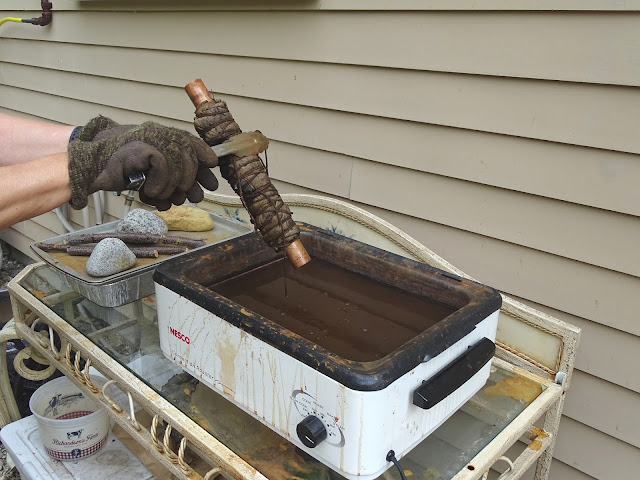JoAnn and David Millen walk three miles daily in Halibut Point State Park that abuts their home, both for exercise and the inspiration it provides for JoAnn’s eco print designs. She dyes fabric from concoctions of organic materials and metal junk. This is the story, in her own words.
 |
JoAnn Millen in her dyeing studio |
To begin my process I choose a light colored fabric like cotton, wool, or silk to print on.
Blackberry leaves make a black or purple print. Here you see an oak leaf surrounded by rose. Onion skins give a wonderful ocher tint. They think I'm an eccentric over at Shaw's, because I clean out the onion bins for them. You have to be a dyer in order to understand.
I collect rose, blackberry, maple, sycamore, oak and many other assorted fallen leaves, bark, and sticks. In the dye pot I include rusty metal objects for additional color and pattern. Eucalyptus leaves can lend a nice red color.
I'm especially proud of my rusty object collection and use certain pieces over and over because of the strong patterns they provide.
Some of these things are golden. I was probably walking down a railroad track when I saw something like that. That's a real find.
After soaking the material briefly in iron water I wrap it with leaves and rusted metal. The string tie will leave a design of its own.
I put the bundle in a dye pot, add vinegar and let it simmer for two hours. Vinegar is the mordant. It facilitates color going into the fabric.
I was in the spice cabinet, and started adding spices to get these oranges and yellows. The little speckles come from black tea.
After I remove and unroll my fabric I can identify the various leaves that I've used. The ones that do not print often lend what's called a resist which can be equally satisfying in the pattern. Unrolling a bundle is a kind of surprise present. You don’t know exactly what you will get. Each piece is unique.
This vessel was built from wool rovings, water, and soap. I wrapped it with leaves and a copper pipe to make the patterns. After removing it from the dye bath I shaped the piece into a vessel. Shaping a vessel into this form can take hours.
The beauty of this art form is evident in the vessels, fabrics, and papers that can be fashioned the environment around us. Halibut Point is my inspiration point.
There are times I use fabric as wrapping paper, a gift of the fabric itself.











Martin, you continue to amaze! What a remarkable tale, beautifully told. Thank you.
ReplyDeleteSo great!
ReplyDeleteWow this is so interesting. Sounds like this would make a great program at the park.
ReplyDelete